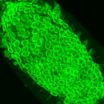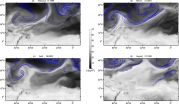Discovering a new force driving cell contraction during development and organogenesis
CRG scientists in Barcelona, Spain describe a new mechanism shaping cells and generating cell contractile forces during development and organogenesis
2015-06-09
(Press-News.org) This news release is available in Spanish.
CRG scientists describe a new mechanism shaping cells and generating cell contractile forces during development and organogenesis.
The new mechanism, which has been published today in the journal Developmental Cell, includes strategies shared with programmed cell death but which have not previously been directly associated with force generation.
Studying developmental processes such as the one presented in the Dev. Cell paper contributes to a better understanding of organ development and maintenance. Also, the specific process of dorsal closure described in this work is one of the most studied ones because of its similarity with wound healing.
Cells and tissues must generate forces to shape organs and for proper development. A team of scientists led by Jérôme Solon at the Centre for Genomic Regulation has just described a new mechanism for the generation of the forces that drive cell movements during development. They were particularly focused on one of the most studied developmental processes: the Drosophila dorsal closure.
Dorsal closure is a process by which skin cells on the embryo stretch over a gap to close it. Briefly, accepted mechanism of this process has been that the edges of the gap form a kind of zipper that pulls the skin cells of the embryo together, to shape them and to lead to the next development stage. There are many research groups studying development and some of them focus in particular on dorsal closure because it is genetically and mechanically similar to wound healing in mammals such as ourselves.
"Mechanisms shaping cells and tissues described until now are based on forces generated by the remodelling of the cell cytoskeletal meshwork and structures that pull, push or shrink cells. What we have now described is that cells can also generate forces simply by modulating their volume", says Jérôme Solon, group leader of the Biomechanics of Morphogenesis group at the CRG in Barcelona.
Solon and colleagues made a quantitative description of dorsal closure at a tri-dimensional level. They imaged the cells and, together with the physicist Guillaume Salbreux at the Francis Crick Institute in London, built a 3D model to enhance our understanding of what was happening at the single cell level. "Surprisingly, we found that cells were not elongating or changing their shape in the manner that was previously thought, but that the cells were actually changing their volume and shrinking." When looking at the cells in most of the mechanisms underlying tissue contraction during development, we can see how they are changing their shape, turning flat cells into pear-like cells without an alteration in volume. However, in this case, the researchers observed that cells retain their thickness but decreased their volume, getting smaller.
When cell death is the engine for life
"The most curious thing is that the mechanisms driving these volume changes are the same as those that have been found during programmed cell death or apoptosis. So, it is important for us to highlight the dual role of apoptosis in this particular developmental process. We feel that these mechanisms are likely to play important roles in other morphogenetic processes shaping tissues and organs, such as wound healing and limb or brain development", concludes Solon.
INFORMATION:
This research has been supported by the Spanish Ministry of Economy and Competitiveness through the Plan Nacional.
Reference:
Saias et al. Decrease in Cell Volume Generates Contractile Forces Driving Dorsal Closure, Developmental Cell (2015). http://dx.doi.org/10.1016/j.devcel.2015.03.013 END
[Attachments] See images for this press release:


ELSE PRESS RELEASES FROM THIS DATE:
2015-06-09
Simple steps that include the consistent use of experienced medical teams for a single type of surgery, preemptive antibiotics before the procedure, less reliance on potent opioids during recovery and urging patients to get out of bed and move around sooner can not only prevent infections, blood clots and other serious complications in people undergoing colorectal operations, but can also accelerate recovery and reduce cost of care, according to results of an ongoing program at The Johns Hopkins Hospital.
The approach, dubbed Integrated Recovery Pathway, or IRP, and its ...
2015-06-09
In a small clinical trial, scientists at Johns Hopkins' Kimmel Cancer Center and James Buchanan Brady Urological Institute found that men with advanced prostate cancer and detection of androgen receptor splice variant-7 (AR-V7) respond to chemotherapy just as well as men who lack the variant.
The findings, the researchers say, may be significant for patients who carry the AR-V7 variant, because they are more likely to develop resistance to one of two hormone drugs routinely used to treat their disease. Results of the trial are published online in the June 4 issue of JAMA ...
2015-06-09
Young adults who use social media to quit smoking are twice as successful in their efforts as those who use a more traditional method, according to new research from the University of Waterloo.
The study, published last week in Nicotine & Tobacco Research, compared the success of the social media-based campaign Break It Off with Smokers' Helpline, a telephone hotline for young adults looking to quit smoking.
After three months in the program, 32 per cent of smokers who used Break It Off apps and web tools had quit smoking, compared to 14 per cent of their peers who ...
2015-06-09
Monsoon rainfall, although a little later than normal, started on June 5, 2015, in southern India. The Global Precipitation Measurement (GPM) core satellite gathered rainfall data that was used to create an animation that shows where the precipitation fell as the season started.
Due to El Nino conditions some meteorologists predict that monsoon rainfall will be below normal this year. Cooling rainfall comes to the country after high temperatures preceding the monsoon have caused the reported deaths of more than 2,300 people.
Data from the NASA's Integrated Multi-satellitE ...
2015-06-09
The remnants of former Hurricane Blanca are blanking out over the northern part of Mexico's Baja California today, June 9. NOAA's GOES-West satellite captured an infrared image of Blanca's remnants revealing a disorganized storm. All watches and warnings have been dropped.
NOAA's GOES-West satellite took an image of Blanca's remnants as it continued moving over the northern Baja California peninsula on June 9 at 1245 UTC (8:45 a.m. EDT). The clouds associated with the remnants were over the northern Baja and over the northern portion of mainland Mexico. The western-most ...
2015-06-09
WASHINGTON, DC, June 9, 2015 - If you want to assign blame on an overcast day, then cast your eyes on the tropics. Water vapor originating from the Earth's tropics is transported to midlatitudes on long filaments of flowing air that intermittently travel across the world's oceans. When these airy tendrils make landfall, they can cause severe floods and other extreme weather events. Yet despite the importance of these "atmospheric rivers" for the global water and heat cycles, the mechanism behind their formation is still a mystery.
But a new study, published this week ...
2015-06-09
Between 1993 and 2012, the incidence rate of acute traumatic spinal cord injury remained relatively stable in the U.S., although there was an increase among older adults, mostly associated with an increase in falls, according to a study in the June 9 issue of JAMA, a theme issue on the Americans with Disabilities Act.
Traumatic spinal cord injury leads to chronic impairment and disability. Despite the substantial effects of this injury on health-related quality of life and health care spending, contemporary data on trends in incidence, causes, and medical care are limited, ...
2015-06-09
A control system that incorporated electrical signals generated during muscle contractions and gait information resulted in improved real-time control of a powered prosthetic leg for different modes of walking (such as on level ground or descending stairs), according to a study in the June 9 issue of JAMA, a theme issue on the Americans with Disabilities Act.
Most prosthetic lower limbs are mechanically passive (cannot provide power) and so do not restore full function. Leg prostheses that provide power are becoming available; however, different ambulation modes require ...
2015-06-09
Among applicants to U.S. medical schools, those with disabilities who obtained extra test administration time for the Medical College Admission Test in use from 1991 to January 2015 had no significant difference in rate of medical school admission but had lower rates of passing the United States Medical Licensing Examination Step examinations and of medical school graduation, according to a study in the June 9 issue of JAMA, a theme issue on the Americans with Disabilities Act.
Individuals with documented mental and physical disabilities may receive testing accommodations ...
2015-06-09
Following implementation of rotavirus vaccination in 2006, all-cause acute gastroenteritis hospitalization rates among U.S. children younger than 5 years of age declined by 31 percent - 55 percent in each of the post-vaccine years from 2008 through 2012, according to a study in the June 9 issue of JAMA.
Eyal Leshem, M.D., of the U.S. Centers for Disease Control and Prevention, Atlanta, and colleagues examined both all-cause gastroenteritis and rotavirus-related hospitalizations among children younger than 5 years from 2000 through 2012. The researchers analyzed State ...
LAST 30 PRESS RELEASES:
[Press-News.org] Discovering a new force driving cell contraction during development and organogenesis
CRG scientists in Barcelona, Spain describe a new mechanism shaping cells and generating cell contractile forces during development and organogenesis




